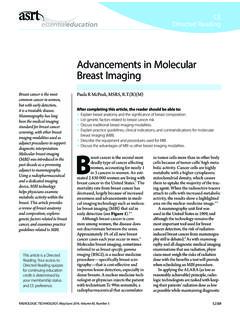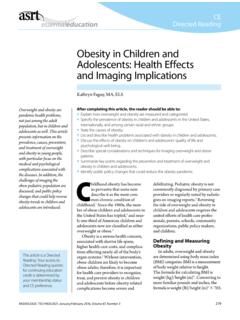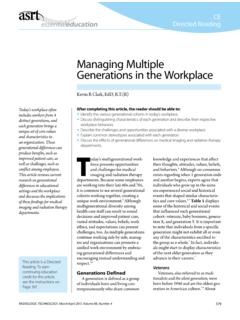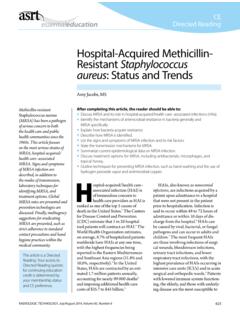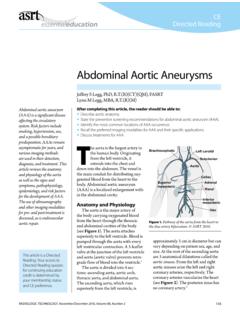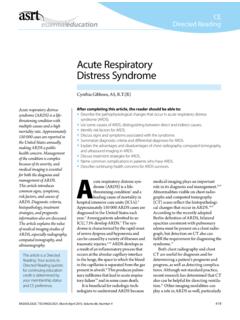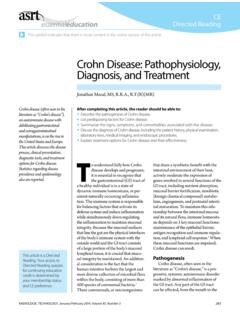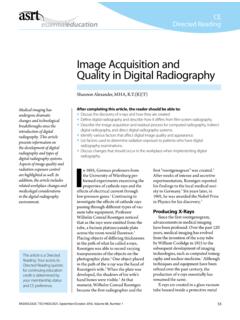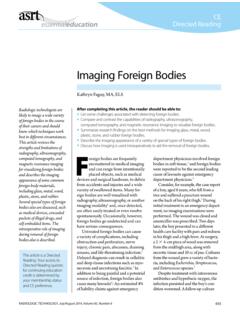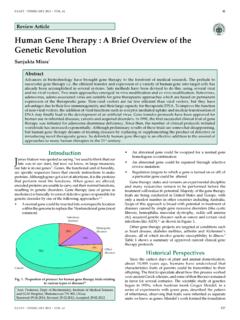Transcription of Low-Dose Computed Tomography Lung Cancer Screening
1 297 CTRADIOLOGIC TECHNOLOGY, January/February 2014, Volume 85, Number 3 CEDirected ReadingLung Cancer is the leading Cancer killer in the United States and the world for both men and ,2 Tobacco smoking is the single most important risk factor for lung Cancer . Environmental and occu-pational exposures to radon, asbestos, and other pollutants also are causes of lung in the diagnosis and treat-ment of lung Cancer promise to extend patients lives, but the probability that treatment will be successful is inversely associated with tumor stage at diagnosis. Patients with metastatic disease face poor prognoses, and those diagnosed with a single well-localized small tumor can survive for many years. Lung Cancer can be prevented, and death rates associated with this disease can be reduced.
2 Primar y prevention efforts to avoid new cases include pub-lic health campaigns to discourage non-smokers from starting and encourage smokers to quit, along with home radon education and testing programs. The main form of secondary prevention is lung Cancer Screening . Secondary prevention efforts are aimed at early detection and intervention to slow the growth and spread of tumors that have already helical Computed tomog-raphy (LD-CT) has been validated by a large randomized clinical trial as supe-rior to chest radiography in the screen-ing and early detection of lung cancers. A lthough not every patient benefits from LD-CT lung Cancer Screening , and some patients undergo unnecessary follow-up procedures as a result of false-positive Screening results, the research indicates that using this imaging modality to screen carefully selected high-risk patient populations for pul-monary tumors will prolong and save lives.
3 Furthermore, every lung Cancer Screening represents an opportunity for educational interventions to encourage patients to pursue smoking cessation. After completing this article, the reader should be able to: List risk factors for lung Cancer . Explain primary and secondary prevention strategies for lung Cancer . Describe selection criteria for Low-Dose Computed Tomography (LD-CT) lung Cancer Screening . Summarize the evidence for LD-CT lung Screening , including the results of the National Lung Screening Trial. Discuss diagnostic follow-up for patients with a positive Screening test. Identify the purposes of Furlow, BALow- dose Computed Tomography Lung Cancer ScreeningThis article is a Directed Reading. Your access to Directed Reading quizzes for continuing education credit is determined by your membership status and CE preference.
4 Lung cancers, primarily caused by tobacco smoking , are the leading cause of Cancer deaths in the United States and around the world. Screening of select high-risk patients using Low-Dose helical Computed Tomography (LD-CT) has been shown to reduce lung Cancer mortality by 20% compared with chest radiography. However, because there are risks to LD-CT lung Cancer Screening , it should be performed only on current or former tobacco smokers. This article introduces readers to the epidemiology, pathobiology, diagnostic imaging, and diagnosis, staging , and treatment of lung Cancer ; primary and secondary prevention strategies; LD-CT lung Screening parameters; research findings; and resulting practice Reading298 CTRADIOLOGIC TECHNOLOGY, January/February 2014, Volume 85, Number 3 Low-Dose Computed Tomography Lung Cancer ScreeningScreening and smoking cessation should be 2 parts of an integrated public health program to reduce the number of tobacco-associated lung Cancer diagnoses and EpidemiologyThe most important risk factor for all types of lung disease is tobacco ,3 Between 43 million and 55 million Americans smoke tobacco.
5 Smoking ultimately contributes to the death of half of those who do not quit before developing a smoking-related disease, including cardiovascular disease or Cancer of the lung, oropharynx, nasal cavity, esophagus, stomach, pancreas, kidney, blad-der, or cervix, or acute myeloid ,4,5 A strong dose -response association links the number of cigarettes smoked with the risk of developing lung Cancer a relationship long denied by tobacco compa-nies but recognized in the medical literature since at least The Surgeon General s report officially link-ing smoking to lung Cancer risk was released in 1964. A link between cannabis smoking and lung Cancer risk remains unclear, however, in part because of legal restrictions on marijuana use.
6 Further, research results are confounded by relatively heav y tobacco use among marijuana ,7 Once a rare disease only about 2000 deaths were attributed to lung Cancer in 19271 more than million new cases are diagnosed each year around the world, and an estimated 221 130 of those are diag-nosed in the United Lung Cancer rates in the United States climbed dramatically throughout much of the 20th century, as smoking became more popu-lar, and peaked in the 1980s before declining in the Recent declines, particularly among men, presumably resulted from tobacco-control legislation and education The absolute number of current smokers in the United States is similar to the 1960s, with up to million active smokers and 50 million recovering or former smokers, yet the percentage of Americans who smoke has declined in recent , 1 in 14 Americans will develop lung Like other leading types of Cancer , lung Cancer is largely a disease of late adulthood, rarely affecting people aged younger than 55 The median age at initial diag-nosis is 71 of all ethnic groups have higher rates of lung Cancer than women (see Ta bl e 1).
7 1,8 A lthough the roots of this sex difference in lung Cancer rates remain unclear, some believe it is a ref lection of heavier smoking habits among men. This disparity has declined over time, with incidence rates of lung Cancer decreasing among men as smaller proportions of men became smokers in recent Unfortunately, cigarette smoking has declined more modestly among young Women also experience superior survival times compared with Disparities between the sexes in lung Cancer incidence and mortality rates also might ref lect biological differ-ences mediated by estrogen. Lung Cancer incidence and mortality in the United States vary by ethnicity, income level, and geography. People with lower education levels and income are markedly more likely to develop lung Cancer than are people with higher levels of education and income, even when smoking history is statistically Researchers have speculated that other inhalation expo-sures in the home or workplace, dietary factors, or poor access to health care and health information might con-tribute to the associations between lung Cancer , educa-tion level, and ,9 Black Americans have markedly higher lung Cancer incidence and mortality rates than do people of other Higher incidence rates among blacks are largely a ref lection of higher tobacco smoking rates in this Racial disparities in survival outcomes after diagnosis, however.
8 Appear to be more complex. Outcomes involve levels of access to Cancer Screening and health care services and possible differences in the quality of care obtained. Black patients lung cancers frequently are diagnosed at more advanced stages of Cancer than whites, but the 5-year survival rates among blacks is lower than those for whites for every Despite having lower income and education levels overall than non-Hispanic whites, Hispanic people have lower rates of lung Cancer and a decreased risk of overall mortality when they are diagnosed with the most com-mon non small cell forms of lung The reasons for this Hispanic paradox of better Cancer rates and outcomes despite lower socioeconomic status remain unclear but might involve self-selection of healthier work-ers who migrate across the the strong association between tobacco use and lung Cancer .
9 An increasing number of lung cancers, particularly adenocarcinomas, has been noted in patients CEDirected Reading 299 CTRADIOLOGIC TECHNOLOGY, January/February 2014, Volume 85, Number 3 Furlowwho have smoked fewer than 100 cigarettes in their entire These so-called never-smokers or non-smokers now represent between 15% and 25% of all lung Cancer patients and an estimated 300 000 deaths each Lung cancers in never-smokers are believed to be caused by household air pollution, such as radon and secondhand tobacco smoke, and ambient or outdoor air Black nonsmokers have higher lung Cancer incidence and mortality rates than white Radon is the second leading cause of lung Cancer , representing 10% of lung Cancer A decay product of uranium-238, radon produces polonium; both radon and polonium are -particle In high-radon geological regions, radon can accumulate in indoor air, particularly in houses with This leads to chronic in-home exposure and increasing lung Cancer Environmental or secondhand exposure to tobacco smoke, sometimes called passive smoking, appears to be involved in lung Cancer rates among nonsmokers.
10 The nonsmoking spouses of smokers face significantly increased risks of lung Cancer compared with nonsmok-ers who do not live with smokers, for Similar research shows that lung function is harmed among workers who breathe tobacco smoke in the workplace a finding that has led to workplace and public area smoking Other environmental and occupational exposures also have been implicated as lung Cancer risk factors. Asbestos, used since the 1800s as a fire-resistant and insulating construction material, is associated with occupational lung diseases, including lung cancers, particularly a relatively rare form of lung Cancer called Limited evidence suggests that asbestos exposure also might increase the risk of other cancers, including malignancies of the throat, kidney, esophagus, colon, and Ambient airborne particulate matter and sulfur diox-ide from the combustion of fossil fuels such as diesel also are likely lung ,14 Infectious carcino-gens such as HIV and human papillomavirus (HPV)
